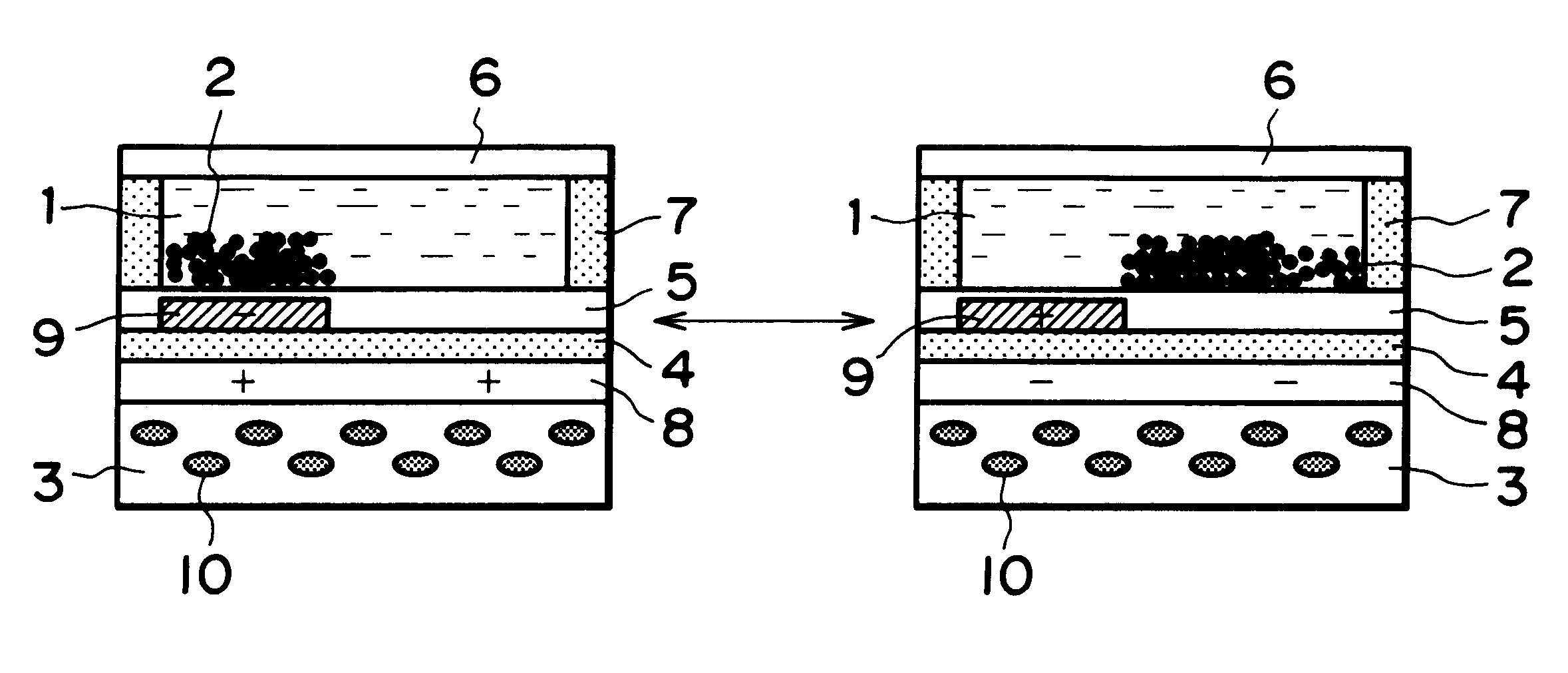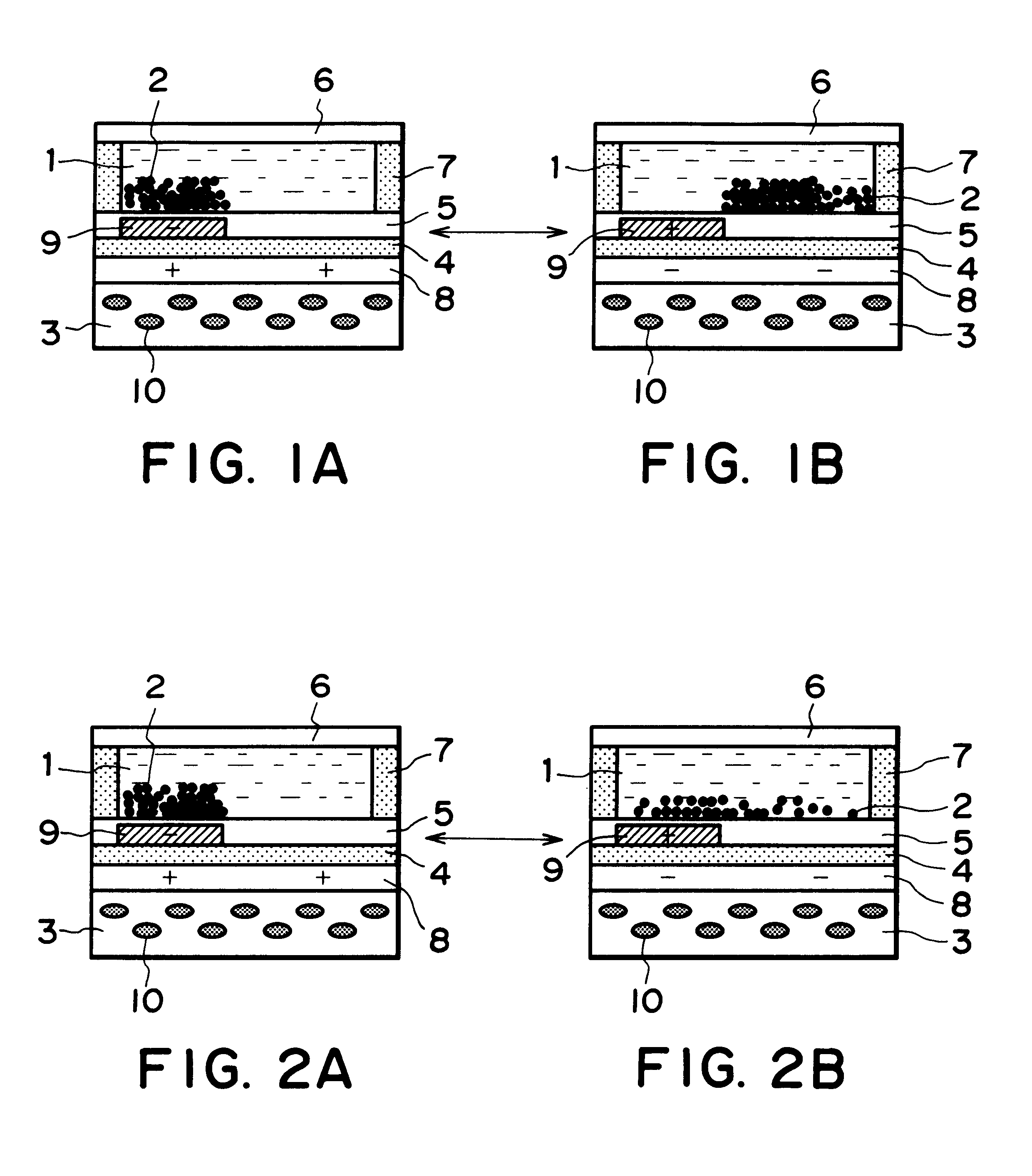Electrophotographic display device and driving method therefor
- Summary
- Abstract
- Description
- Claims
- Application Information
AI Technical Summary
Problems solved by technology
Method used
Image
Examples
example 1
A display device having a matrix of pixels (cells) arranged in 450 rows.times.450 columns was prepared in a planar size of 75 mm.times.75 mm. The display device had a unit cell (pixel structure having planar size of 120 .mu.m.times.120 .mu.m as illustrated in FIGS. 1A and 1B and was prepared in the following manner with reference to FIGS. 4A-4E illustrating production of one unit cell size.
Ferromagnetic cobalt-samarium alloy fine powder 10 was kneaded with melted PET (polyethylene terephthalate) to form a 200 .mu.m-thick film, which was magnetized to provide a first substrate 3 (FIG. 4A) in an entire planar size of 75 mm.times.75 mm.
Then, the first substrate 3 was surface-coated by sputtering with a 200 nm-thick aluminum (Al) film which was then patterned into 120 .mu.m-wide stripes of first electrodes 8. Then, the first electrodes 8 were coated with a 3 .mu.m-thick first insulating layer 4 of PMMA (polymethyl methacrylate) colored in white with titanium oxide fine particles (FIG. 4...
example 2
A display device of 450.times.450 pixels similar to the one of Example 1 except for a unit cell structure of 120 .mu.m.times.120 .mu.m as illustrated in FIG. 3 was prepared in a manner described below with reference to FIGS. 5A-5E similarly as in Example 1.
Ferromagnetic alnico fine powder 1 was mixed with polyimide varnish, and the resultant paint was applied onto a 100 .mu.m-thick PES film 3 and baked to form a magnetic layer 51, which was then magnetized (FIG. 5A).
Then, the first electrode 3 provided with the magnetic layer 51 was coated with an Al film, followed by patterning to provide first electrodes 8, and then with a white first insulating layer 4 of polyimide colored in white by inclusion of titanium oxide fine particles (FIG. 5B).
Then, a dark black-colored titanium carbide film was formed on the insulating layer 4 and patterned by photolithography including dry etching into 30 .mu.m-wide stripes of second electrodes 9. Then, in parallel with the stripes of second electrode...
example 3
The display device prepared in Example 1 was driven for gradational display in the following manner.
First, similarly as in Example 1, when the second electrode 9 was supplied with +80 volts for 30 msec. while the first electrode 8 was grounded (0 volt), the positively charged electrophoretic particles 2 were moved to mask the white first insulating layer 4 on the first electrode 8, thereby providing a black display state as viewed from the side of the second substrate 6 (FIG. 1B).
Then, when the first electrode 8 was supplied with +80 volts for 30 msec while the second electrode 9 was grounded, the positively charged electrophoretic particles 2 were moved onto the second electrode 9 to expose the while color of the first insulating layer 4 thereby providing a slightly grayish white display state (FIG. 2A).
Then, again from the state shown in FIG. 1B, the first electrode 8 was supplied with +80 volts for 5 msec instead of 30 msec while the second electrode 9 was grounded, whereby a por...
PUM
 Login to View More
Login to View More Abstract
Description
Claims
Application Information
 Login to View More
Login to View More - R&D
- Intellectual Property
- Life Sciences
- Materials
- Tech Scout
- Unparalleled Data Quality
- Higher Quality Content
- 60% Fewer Hallucinations
Browse by: Latest US Patents, China's latest patents, Technical Efficacy Thesaurus, Application Domain, Technology Topic, Popular Technical Reports.
© 2025 PatSnap. All rights reserved.Legal|Privacy policy|Modern Slavery Act Transparency Statement|Sitemap|About US| Contact US: help@patsnap.com



